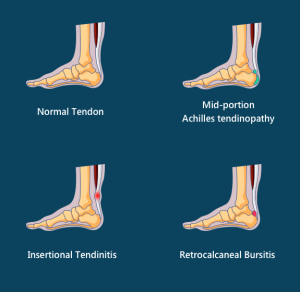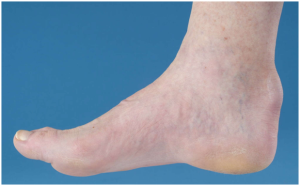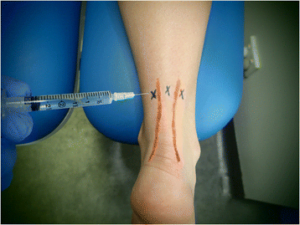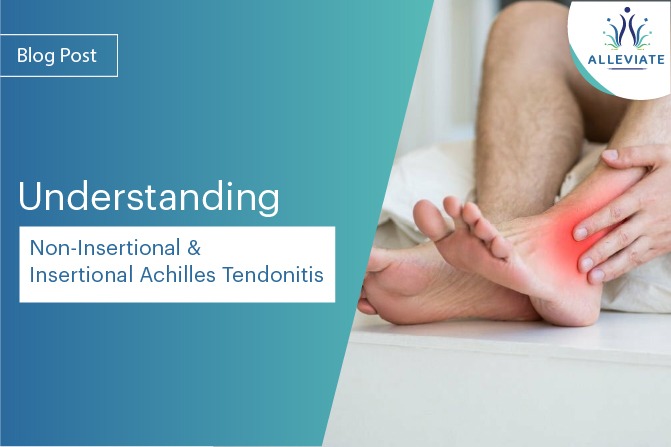Introduction
Achilles tendonitis is a common and painful condition that affects countless individuals, particularly athletes and active individuals. It can manifest in different forms, with non-insertional and insertional Achilles tendonitis being two distinct varieties. In this comprehensive guide, we will explore the causes, pathogenesis, diagnosis, and treatment options for both types, with a focus on the potential benefits of Platelet-Rich Plasma (PRP) and Prolotherapy. We will also discuss exercises to manage and prevent Achilles tendonitis and introduce Alleviate, a specialized center that offers innovative image-guided comprehensive PRP with Prolotherapy treatments.
Understanding Achilles Tendonitis
Before delving into the specific types of
Achilles tendonitis, it’s essential to understand the condition itself. The Achilles tendon is the largest and strongest tendon in the body, connecting the calf muscles to the heel bone. Achilles tendonitis refers to the inflammation of this tendon, and it can occur in two primary forms: non-insertional and insertional.
Common Causes of Achilles Tendonitis
- Overuse and Repetitive Stress : Engaging in activities that place excessive strain on the Achilles tendon, such as running, jumping, or sudden increases in physical activity, can lead to tendonitis.
- Age and Degeneration : As individuals age, the tendon may naturally degenerate, becoming less flexible and more prone to injury.
- Improper Footwear : Ill-fitting or unsupportive footwear can contribute to Achilles tendonitis by altering the mechanics of the foot and placing added strain on the tendon.
- Abnormal Foot Mechanics : Conditions like overpronation or flat feet can place increased stress on the Achilles tendon.
- Tight Calf Muscles : Inflexible calf muscles can strain the Achilles tendon during physical activities.
- Direct Trauma : A sudden impact or injury to the tendon can cause inflammation.
Pathogenesis of Achilles Tendonitis
The pathogenesis of
Achilles tendonitis involves the breakdown of collagen fibers within the tendon due to repetitive microtrauma. This results in inflammation and pain. For non-insertional Achilles tendonitis, the damage occurs in the middle part of the tendon, away from the heel bone, while insertional Achilles tendonitis involves damage at the tendon’s attachment site to the heel bone. it is commonly associated with Retrocalcaneal Bursitis.

Pathologies of the Achilles tendon
Non-Insertional Achilles Tendonitis
Non-insertional Achilles tendonitis primarily affects the middle portion of the Achilles tendon. Understanding this type’s causes, symptoms, diagnosis, and treatment options is crucial for effectively managing the condition.
Causes of Non-Insertional Achilles Tendonitis
Non-insertional
Achilles tendonitis is often attributed to overuse, excessive physical activity, and tight calf muscles. It typically affects active individuals who place a significant load on their Achilles tendon.
Symptoms and Diagnosis
- Pain : Individuals with non-insertional Achilles tendonitis experience pain and swelling in the middle portion of the tendon.
- Stiffness : Stiffness in the calf and Achilles region, particularly in the morning or after periods of rest.
- Thickening : A noticeable thickening of the tendon, indicating damage.
Diagnosis often involves a thorough physical examination by a healthcare professional, and imaging studies, such as ultrasound or MRI, can confirm the diagnosis.
Treatment Options for Non-Insertional Achilles Tendonitis
Platelet-Rich Plasma (PRP) and Prolotherapy
PRP and
Prolotherapy have emerged as promising treatment options for non-insertional Achilles tendonitis. PRP involves injecting a concentration of the patient’s platelets and growth factors into the affected area, promoting healing and reducing inflammation. Prolotherapy, on the other hand, involves the injection of an irritant solution to stimulate tissue repair.
Research published in the
American Journal of Sports Medicine in 2019 suggests that PRP can significantly reduce pain and improve function in non-insertional Achilles tendonitis patients. Prolotherapy has also shown promise in promoting tendon healing, as reported in the
Journal of Prolotherapy in 2020.
Exercises
Physical therapy and specific exercises can complement PRP and Prolotherapy treatment. Strengthening exercises, calf stretches, and eccentric exercises, such as heel drops, are commonly recommended to improve tendon function and prevent recurrence.
Insertional Achilles Tendonitis

A case of Insertional Achilles Tendonitis with Hagelund Deformity Insertional Achilles tendonitis affects the lower portion of the tendon, where it attaches to the heel bone. Understanding its causes, symptoms, diagnosis, and treatment options is vital for those dealing with this type of Achilles tendonitis.
Causes of Insertional Achilles Tendonitis
Insertional Achilles tendonitis can be caused by a variety of factors, including:
- Chronic pressure on the heel bone.
- Calcification within the tendon.
- Haglund’s deformity, an abnormal bony growth on the back of the heel.
- Sudden increases in physical activity.
Symptoms and Diagnosis
- Pain : Individuals with insertional Achilles tendonitis experience pain directly at the back of the heel, particularly with activity.
- Swelling : Swelling and tenderness at the attachment site of the Achilles tendon.
- Bone Spurs : In some cases, insertional Achilles tendonitis may lead to the formation of bone spurs.
Diagnosis typically involves a physical examination and imaging studies, such as X-rays or MRI, to assess the extent of tendon damage and the presence of calcification or bone spurs.
Treatment Options for Insertional Achilles Tendonitis
Platelet-Rich Plasma (PRP) and Prolotherapy
PRP and Prolotherapy have shown potential benefits for insertional Achilles tendonitis. A study published in the
Journal of Orthopaedic Surgery and Research in 2018 reported that PRP injections significantly reduced pain and improved function in patients with insertional Achilles tendonitis. Prolotherapy has also demonstrated positive results in encouraging tendon healing and reducing pain, as documented in a review published in the
American Journal of Physical Medicine & Rehabilitation in 2017.
Steroid Injections
In cases where calcification is present, and the area is very tender, corticosteroid injections may be considered. Steroids can help reduce inflammation and relieve pain.
Exercises
Physical therapy and exercises play a crucial role in the management of insertional Achilles tendonitis. Stretching exercises, eccentric calf raises, and heel lifts can help improve flexibility and strength.
The Role of PRP and Prolotherapy in Achilles Tendonitis

PRP and Prolotherapy have gained popularity in the field of orthopedics due to their regenerative properties. In both non-insertional and insertional Achilles tendonitis, these therapies can provide several benefits:
- Reduced Pain : PRP and Prolotherapy can effectively reduce pain and inflammation in the affected tendon.
- Improved Healing : These treatments stimulate the body’s natural healing processes, promoting tissue repair and regeneration.
- Minimally Invasive : PRP and Prolotherapy are minimally invasive procedures with a low risk of adverse effects, making them suitable for many patients.
While PRP and Prolotherapy offer promising results, individual responses may vary. The treatment protocol should be tailored to each patient’s specific needs and condition severity.
Exercises for Achilles Tendonitis

In addition to the aforementioned treatments, exercises play a vital role in managing and preventing Achilles tendonitis. Here are some exercises that can help:
- Calf Stretch : Stand facing a wall, place your hands against it, and step one leg back while keeping it straight. Bend the front knee and lean toward the wall to feel a stretch in the calf of the back leg. Hold for 30 seconds and repeat on both sides.
- Eccentric Heel Drops : Stand on the edge of a step with your heels hanging off. Rise up on your toes, then slowly lower your heels below the step’s level. Do this exercise with both legs to improve calf strength.
- Towel Scrunches : Sit in a chair with your feet flat on the floor. Place a towel on the ground, and using your toes, scrunch the towel toward you. This exercise helps strengthen the small muscles in the foot and ankle.
Alleviate: Leaders in Comprehensive PRP with Prolotherapy
At Alleviate, we have successfully helped numerous individuals suffering from Achilles tendonitis. Our specialized approach involves image-guided comprehensive PRP with Prolotherapy treatments. We combine advanced medical imaging with regenerative therapies to precisely target the damaged area, maximizing the effectiveness of the treatment.
Our expert team is committed to providing innovative and personalized care to help individuals regain their mobility, reduce pain, and achieve long-term relief from Achilles tendonitis.
Conclusion
Achilles tendonitis is a painful condition that can significantly impact one’s quality of life, but with the right diagnosis and treatment, individuals can overcome this challenge. Non-insertional and insertional Achilles tendonitis each have their unique characteristics and require specific approaches to management. Platelet-Rich Plasma (PRP) and Prolotherapy offer promising results in alleviating pain and promoting healing in both types, while exercises play a vital role in rehabilitation and prevention.
For those seeking comprehensive and
innovative treatment, Alleviate’s image-guided comprehensive PRP with Prolotherapy therapies provide a cutting-edge solution. It is essential to consult with a
healthcare professional to determine the most suitable treatment plan based on individual needs and condition severity. Achilles tendonitis doesn’t have to be a lifelong burden, and with the right approach, individuals can regain their mobility and lead an active, pain-free life.
References
Image taken from
https:// www.verywellhealth.com/ pt-exercises-for-achilles- tendonitis-5202656

 A case of Insertional Achilles Tendonitis with Hagelund Deformity Insertional Achilles tendonitis affects the lower portion of the tendon, where it attaches to the heel bone. Understanding its causes, symptoms, diagnosis, and treatment options is vital for those dealing with this type of Achilles tendonitis.
A case of Insertional Achilles Tendonitis with Hagelund Deformity Insertional Achilles tendonitis affects the lower portion of the tendon, where it attaches to the heel bone. Understanding its causes, symptoms, diagnosis, and treatment options is vital for those dealing with this type of Achilles tendonitis.
 In addition to the aforementioned treatments, exercises play a vital role in managing and preventing Achilles tendonitis. Here are some exercises that can help:
In addition to the aforementioned treatments, exercises play a vital role in managing and preventing Achilles tendonitis. Here are some exercises that can help:






